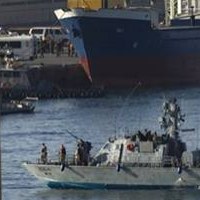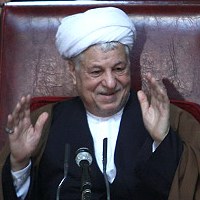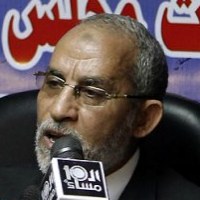![]()
Wed, June 29, 2011 | Rubin Reports | By Barry Rubin

A missile in front of a poster of the Iranian supreme leader Ayatollah Ali Khamenei during a military exhibition in Tehran, Iran. (Photo: Hasan Sarbakhshian/AP)
Israel’s Strategic Standpoint: Mid-2011 and Mid-“Arab Spring”
There are two types of strategic perspectives in Israel today. They aren’t contradictory but they have different priorities. These can be called the “northern” and the “southern” views.
The “northern” approach is the more traditional one, focusing on the situation in that direction. The key longer-term concern is over Iran and its drive for nuclear weapons. More closely, there are both concerns and hopes regarding Lebanon and Syria.
Regarding Iran, the new feature is the assumption that Israel will not attack Iran to prevent it from getting nuclear weapons. This means that Israel will be constructing a multi-level defensive system that includes long-range attack planes, a capability of subverting Iran’s nuclear force through covert operations, possibly submarine platforms, and several types of anti-missile missiles and defenses.
The goal here is four-fold:
— To delay as long as possible Iran getting nuclear weapons and to minimize the size and effectiveness of its arsenal through sanctions, international pressure, sabotage, and other means.
— To have the maximum ability to deter Iran from launching a nuclear attack on Israel and showing the ability to stop Iranian missiles. The aim is to discourage Iran from launching such an attack given a near-certainty that it can be stopped and Iran will suffer very heavy damage as a result.
— Of course, ordinary deterrence is not a sufficient safeguard against Iran given the Islamic regime’s ideological extremism and passionate hatred of Israel, the recklessness of some key elements there, and the rulers’ shortcomings in accurately assessing reality. Consequently, Israel must put a high priority on stopping any Iranian attack from happening at all or succeeding if it does happen.
— To be able, if Israel ever determines there is a real danger of an Iranian attack, to launch a first strike to inflict maximum damage on Iran’s nuclear strike force. In other words, an Israeli attack would be premised not on Iran getting nuclear weapons but on Iran being likely to use nuclear weapons.
U.S. deterrence, early-warning, and anti-missile efforts would supplement this system but this strategy is not premised on any dependence on the U.S. government.
But Israel also knows that an equal or even greater danger is the spread of Iranian influence, taking over Arab countries or turning them into clients that can be used against Israel. Here, the northern focus is on Syria and Lebanon.
On the surface, the news from these two countries is potentially bad. Lebanon is now ruled by a government controlled by Hizballah and other Syrian or Syrian-Iranian clients. Hizballah thus can use Lebanon as a virtual fiefdom for building its military power and attacking Israel. This is much worse than the 2006 Hizballah-Israel war when Lebanon as a government and army had a separate identity.
Syria itself is faced with a serious internal upheaval that seems increasingly likely to bring down the dictatorship of President Hafiz al-Asad. Here the “glass half-empty” analysis is that Asad might be replaced by an Islamist or radical regime even more hostile to Israel.
There is also, though, a “glass half full” analysis. As long as Syria is in such turmoil, it cannot so effectively threaten Israel. And if Asad is overthrown a government might take power that is more preoccupied by internal affairs, perhaps less eager to be in conflict with Israel.
Iraq offers a good model here. Between the interests of the Kurds, the internal conflict, a greater focus on domestic development, and other factors, Iraq has dropped out of the conflict with Israel.
Hizballah also suffers from this turmoil. Since it has sided with the Asad regime, Hizballah has gone from wildly popular to widely hated by the Syrian people. Hamas, which has sided against the Syrian regime and in favor of its Muslim Brotherhood comrades, has lost Syrian patronage. Finally, Syria’s aggressive behavior has opened up a rift between that country and Turkey’s government, which has been increasingly acting like an ally of the Iranian and Turkish regimes.
Consequently, while this is no ideal or wonderful situation, Israel can be considered to have benefitted from this aspect of the “Arab Spring.”
From Israel’s standpoint, the relative stability in Jordan and Saudi Arabia is a plus since these countries are unlikely to be transformed into radical Islamist states under a government linked to al-Qaida, Iran, or the Muslim Brotherhood. The turmoil in Bahrain, Yemen, and Tunisia is of relatively little strategic significance to Israel.
Generally, there can be a hope that democracy and domestic development will become a higher priority than fighting Israel, thus easing the pressure on Israel, or at least preoccupying Arabs and Muslims for a while. Clearly, merely calling dissidents Zionist agents and trying to unite the people around an anti-Israel political platform no longer works for incumbent nationalist governments.
In time, this strategy might work for replacement, Islamist governments but that hasn’t happened yet. Moreover, American weakness and the Obama Administration’s cooler view toward Israel is worrisome. So is the possibility that things might be moving in a way to strengthen Iran.
If one looks at the southern front, though, it is harder to find some possible silver lining. Egypt is likely to elect a radical government more hostile than anything Israel has faced there since about 1974. The future of the Egypt-Israel peace treaty is gloomy. Peace between Israel and the Arab world’s most populous country cannot be taken for granted.
There is also the problem of the Egypt-Hamas relationship. Egypt is likely to see itself as Hamas’s ally and patron. In a future Israel-Hamas conflict begun by an attack on Israel from the Gaza Strip any time Hamas so wishes, Egypt could actively take the side of the Palestinian Islamists and will certainly help them. The long-quiet southern front now has to be treated as a very possible zone of armed conflict.
This is the basic way things look for Israeli strategists. One can stress better- or worse-case scenarios and different parts of the challenge but there is a general consensus on the fundamental challenges — and on the fact that they will be met successfully.
About the author,
Barry Rubin, director, Global Research in International Affairs (GLORIA) Center; editor, Middle East Review of International Affairs (MERIA) Journal; and featured columnist http://pajamasmedia.com/barryrubin/. His latest books are The Israel-Arab Reader (seventh edition), The Long War for Freedom: The Arab Struggle for Democracy in the Middle East (Wiley), and The Truth About Syria (Palgrave-Macmillan). The website of the GLORIA Center is http://www.gloria-center.org/. His articles published originally in places other than PajamasMedia can be found at http://www.rubinreports.blogspot.com/.



 RSS
RSS











Israel’s Strategic Standpoint: Mid-2011 and Mid-“Arab Spring” | #Israel #Iran #Syria #Lebanon #Hezbollah #Hamas http://bit.ly/joZrgo
Israel’s Strategic Standpoint: Mid-2011 and Mid-“Arab Spring” | #Israel #Iran #Syria #Lebanon #Hezbollah #Hamas http://bit.ly/joZrgo
Israel’s Strategic Standpoint: Mid-2011 and Mid-“Arab Spring” | #Israel #Iran #Syria #Lebanon #Hezbollah #Hamas http://bit.ly/joZrgo